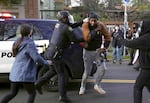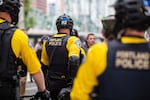
Illustration by Rita Sabler for OPB
Shortly after midnight on Aug. 29, 2022, Portland police Officer Nicholas Wambold responded to reports of an alleged assault outside a bar in southeast Portland. Witnesses described a man who had been threatening passersby and, when confronted, had punched someone in the face.
Upon arrival, Wambold and other officers encountered a 54-year-old man in the middle of the street, who appeared to be under the influence of drugs. Wambold described the man’s behavior as “erratic” and “abnormal” in his notes.
When Wambold tried to handcuff the man, the man reportedly curled up in a ball and pulled his arms away. According to officers’ notes, Wambold then “straddled” the man and forcibly snapped handcuffs on his wrists. After the man refused to stand and walk to a patrol car, Wambold and other officers tried to pick him up and lift him into the vehicle, while he reportedly flailed and kicked. They succeeded only after two failed attempts.
“No further force was used,” Wambold wrote in a Force Data Collection Report filed later that morning. In this report, which officers are required to fill out whenever they use force against someone, Wambold described four instances of force: the handcuffing and the three attempts to physically move the man into a patrol car.
According to data shared publicly by the Portland Police Bureau, this was the 15th time Wambold reported using force during an arrest in 2022. He’d use force two more times that year. While all of the types of force he used were considered minor, he reported using force at a rate five times higher than the average Portland officer in 2022.
Wambold, a patrol officer assigned to the Police Bureau’s East Precinct, is one of a handful of Portland police officers who consistently report using force against Portlanders at a yearly rate far higher than their peers.
According to PPB’s publicly available use of force data, most of the top 20 officers who reported using force most frequently in 2022 also appeared at the top of the list once in the five years prior. One officer appears in the top 20 ranking six years in a row.
Wambold was hired in 2019. In 2021, Wambold used force 11 times, nearly four times higher than the average officer. Incomplete data from 2023 shows that Wambold used force at least 10 times last year. The majority of this force is considered minor. But in April 2023, Wambold shot and killed a man suspected of murder.
The trend of the same few PPB officers using force frequently year after year isn’t new. Portland is under a settlement agreement with the U.S. Department of Justice over problematic police use of force. For years, a group of court-appointed advisers has raised concerns with this pattern, and police leaders have promised changes. But little has changed.
Like Wambold, those who report using force most frequently are all relatively recent hires, and all are up-to-date on required officer training.
As Portland enters its 10th year under DOJ scrutiny, this pattern of force raises questions about the city’s ability to address heavy-handed policing. Experts say the data shows that Portland may be missing clear opportunities to intervene before an officer’s force turns deadly, while others argue that the data could exaggerate concerns because certain police assignments are invariably more prone to arrests and therefore result in more force. The police say that officers’ actions are usually warranted to keep the public safe.
“The Bureau recognizes that members may need to use force in the performance of their duties,” said PPB spokesperson Kevin Allen.
Most people who spoke with OPB agreed that, even if officers are found to be following city policy when using force, this trend is worth examining.
“The goal of law enforcement should be avoiding harm when possible,” said Joanna Schwartz, a law professor at the University of California, Los Angeles who specializes in police accountability. “When you see an officer engaging in a cluster of repeatedly using force far more than his peers, clearly there’s something about the way in which that officer is doing their job that, while it may be legal, may be unnecessary.”
How Portland police define ‘force’
Under a 1989 U.S. Supreme Court ruling, law enforcement officers are allowed to use force that is “objectively reasonable” to arrest someone or otherwise gain control of a situation where public safety is at risk. That ruling created a so-called “reasonableness standard,” by which an officer’s actions must be judged by the circumstances at the scene, “rather than with the 20/20 vision of hindsight.”
This ruling informs Portland’s own use-of-force rules and regulations for officers: “Members shall only use force necessary to accomplish a lawful objective, and the force must be objectively reasonable under the totality of the circumstances.”
The city also requires officers to attempt to de-escalate an interaction with someone before using force, and instructs officers to warn members of the public before using force.
In Portland, force falls into four different categories, with Category I being deadly force and Category IV being “force that is intended to establish control of a resistant person, though not reasonably likely to cause persistent pain or physical injury.” Category IV force includes forceful handcuffing or pushing someone to keep them from running away, like Wambold’s actions outside the southeast Portland bar.

FILE - Police arrest a protester outside the Red House in Portland, Ore., where a group of people attempted to stop an eviction process Dec. 8, 2020.
Jonathan Levinson
Police management is responsible for reviewing each instance of force reported by an officer, and determining whether it is reasonable. Those supervisors are also responsible for disciplining officers who violate use of force policy, which can range from a verbal warning to a demotion. If an officer uses deadly force or uses force that sends someone to the hospital, that incident must be reviewed by an advisory board which recommends discipline that the police commissioner or chief of police can accept or reject.
Why use-of-force reports have increased in Portland
The majority of force used by officers in Portland is lower-level and is rarely found to be unreasonable by police management, which makes it hard to critique from the outside.
“One of the things that make use of force so difficult is that officers get to and, in some situations, are required to use force in the course of their jobs,” said Seth Stoughton, a criminology professor at the University of South Carolina. “So just having it happen isn’t really enough to allow us to assess whether it’s misconduct or not.”
Stoughton, a former police officer, said there are a lot of questions to consider when reviewing officers’ use-of-force trends.
“Are these officers being more aggressive than they should be? Are they just treating people really rudely and people are responding to that?” Stoughton said. “Or are the officers using bad tactics where they’re putting themselves into dangerous situations and then having to use force to address the danger of those situations?”
He pointed to several explanations for why some officers may be using force more frequently than others. For example, maybe those officers are assigned to a certain department that patrols areas with higher crime rates, or during specific times of the day when more arrests are made.
“You also may be looking at officers who have specific assignments where they are more likely to engage in the type of police action like arresting or detaining that carry a higher probability of force,” he said.
PPB echoed this explanation in a response to OPB. Terri Wallo Strauss, another spokesperson for the bureau, said that an officer may use force more frequently if they work in areas that see higher rates of people overdosing from drugs — a population she said may resist medical treatment. This is also the case for officers who assist paramedics in restraining people experiencing a mental health crisis.
“Those officers may show a higher percentage of force than an officer who may work in a neighborhood district that doesn’t generally have those types of calls,” Wallo Strauss said.
Related: Overdoses have become a daily reality on the streets of Portland
A recent report by a research group that advocates for police abolition named Ctrl-Alt-Defund used PPB data to identify all officers who used the most force during the first nine months of 2023. (The bureau has yet to tabulate data collected in the fourth quarter of the year.)
PPB’s Allen pointed to the top officer on that list, Damien Dale, as an example of how additional context can explain frequent force. Data show that Dale used force against 23 people during the first nine months of 2023. Allen said that the majority of force Dale used were “tactics with a low likelihood of causing injury.”
Allen explained that Dale is assigned to work in the Central Precinct, an area that includes downtown and has “been identified as having a great need for police services due to crime and disorder.” Allen also noted that some of the force Dale used was necessary to perform a civil hold — a term for when an officer believes that someone’s mental health has made them dangerous to themselves or others, and transports them to a hospital.
All force that Dale used during that time period was reviewed by PPB managers and, according to Allen, “found to be objectively reasonable force necessary to perform their duties.”
Wallo Strauss stressed that the amount of force used by officers is minimal compared to the number of interactions police have with the public. In 2022, police responded to 278,128 emergency calls. According to PPB, officers used force on the scene of only 0.23% of those calls; 74% of the 646 total cases in which officers used force ended in an arrest.
“It is important to keep the numbers in perspective,” Wallo Strauss said.
There are other factors that could contribute to officers’ high use-of-force rates.
Schwartz, the UCLA professor, noted that the high rate of officers reporting force could also be influenced by the DOJ’s role in Portland police oversight. In 2014, the DOJ entered a settlement agreement with Portland to address what federal prosecutors alleged was a habit of unconstitutional use of force by police against people with a mental illness. That agreement requires PPB meet certain requirements, including heightened tracking and analysis of all use-of-force reports.
“The fact that use-of-force reports might go up in a department that is being subject to DOJ oversight doesn’t necessarily mean that there’s increased force,” Schwartz said. “It means that there’s increased reporting.”
But policing experts contracted by the city to oversee the settlement agreement — representatives from the nonprofit Center for Justice Research and Innovation — remain alarmed by this pattern.
Related: Oregon open carry law creates training challenge for police (2018)
The group issues quarterly reports to a federal judge on how Portland is meeting its settlement goals. Frequently, these reports highlight how certain officers are using force more frequently than others.
“As we have stated in past reports, the PPB uses an overall low level of force,” reads the group’s May 2023 report. “However, as discussed in several areas within this assessment report, the PPB has still yet to fully explore ways to further manage uses of force, including by better assessing individual officers who use comparatively higher levels of force and scrutinizing actions that, even if within policy, may represent an area for improvement.”
The group regularly recommends that, by addressing this trend, the city will be closer to being released from the decade-old DOJ agreement, which the city has bemoaned for being costly and time consuming.
Mayor Ted Wheeler, who serves as Portland’s police commissioner and has played a direct role representing the city in the DOJ settlement, declined to comment on the trend.
Low-level force may be a predictor for deadly force
It’s often the more extreme police use-of-force incidents — ones that result in death or serious injury — that grab headlines and spur protests in Portland and across the country. But officers responsible for those actions often have records of using more low-level force than their peers.
As an example, Schwartz points to perhaps the most notorious case of an officer using deadly force in recent history: the murder of George Floyd. The Minneapolis officer convicted of killing Floyd, Derek Chauvin, had a long history of using non-deadly force against members of the public — far higher than his peers.
“That’s sort of a prime example of a situation where an officer had all sorts of prior uses of force that may not have been fatal,” Schwartz said. “And no one intervened.”
Related: Portland crime rates dropped in 2023, data shows
This pattern appears in PPB’s data. Ten officers who used low-level force at a rate far higher than their peers in the past five years have shot and either injured or killed a member of the public.
Officer Wambold is one of those officers. Last April, he shot and killed a man suspected of murdering someone earlier in the day. That fatal shooting was just one of four times Wambold used force in April.
In June, a grand jury determined that Wambold’s decision to shoot the man was justified.
How police departments can intervene
This deadly trend isn’t inevitable.
Policing experts say this pattern can be stopped with programs referred to as “early intervention systems.” These software programs track officer data to identify any officers who may be on a concerning trajectory, whether that’s due to frequent uses of force or a growing number of complaints from the public. These programs alert supervisors to any risky patterns early on, with the hope that an intervention — anything from training to a temporary reassignment — will change officer behavior.
South Carolina professor Stoughton, who advises police departments on intervention techniques, said that it’s important to track patterns. In his previous work advising a South Carolina law enforcement agency, he observed one officer who reported using force at an above-average rate.
“When you looked individually at each use of force, it was easy to sign off on,” he said. “They were all low levels of force, and the officer was more or less within policy.”
But, after supervisors watched body camera footage of each incident in a sequence, they noticed a pattern of this officer approaching people in a way that unnecessarily escalated each situation. The agency ended up firing the officer.
“That’s not necessarily the only intervention,” said Stoughton. “There could be specific training or discipline. But the first step is you have to do the work of identifying the issues, and that means looking across incidents for patterns and trends.”
Related: Portland City Council approves $10M in additional spending for police body-worn camera program
PPB supervisors may be missing this opportunity.
Portland relies on an intervention program called the Employee Information System. That program alerts patterns in officer use of force to an administrator who works in the bureau’s Office of Inspector General.
If that administrator finds “statistically meaningful deviations from normative behavior” in an officer’s use of force, that officer’s supervisor is notified. That supervisor must give the administrator a plan on how to address their officers’ possible missteps within 30 days.
Portland police data shows that officers reported using force 1,393 times in 2022. In the bureau’s 2022 annual report, PPB notes that managers were alerted of officers using an unusual pattern of force 199 times. And in 30% of those cases, the alert prompted a manager to have a “conversation with the employee.” PPB did not say whether the other 70% of alerts were addressed or dismissed.
The latest quarterly report by the advisory group overseeing Portland’s DOJ settlement shines more light on this system and its shortcomings. The report looks at force data collected between April 1 and July 30, 2023. The analysts specifically identify an “absence of interventions” for officers who use force more frequently than others.
They point to one officer who used force 15 times over the past year. PPB’s intervention system flagged the officer’s force use five times in the past three months, but their supervisor did not respond to any of those alerts. The report concludes that of officers who use force the most frequently, less than half receive an intervention. And the only type of intervention they received is “coaching” from a supervisor, which is a catchall term for one-on-one mentoring.
The advisers ask PPB “for better clarity with how outlying officers, teams, and units are identified and evaluated in the context of early intervention” to meet the requirements of the DOJ settlement.

FILE - Portland police officers on bicycles at a rally in Portland, Ore., Saturday, Aug. 17, 2019.
Bradley W. Parks / OPB
Early intervention systems have worked in Portland before. In researching a 2012 paper on how litigation impacts policing, Schwartz spoke to former Portland city attorney David Woboril, who explained that the city noticed a pattern of lawsuits against officers hitting people in the head in the 2010s. Closer review found that the accused officers primarily worked a night shift at the same police station.
“Following retraining and closer supervision, allegations of head strikes in that station declined,” Schwartz’s study concludes.
The role of officer training
Portland police say they also rely on training to address any force concerns with officers. Each year, the department conducts evaluations on whether or not certain training programs are addressing bureau issues. PPB Chief Bob Day led the bureau’s Training Division for years before entering the chief’s office in 2023. The bureau did not make him available for an interview.
All of the officers identified for using force most frequently in the past five years are up-to-date on the latest trainings, including sessions that focus on use of force.
Officer Wambold, who used force 17 times in 2022, completed a use-of-force training a month before roughly handcuffing the 54-year-old man in southeast Portland in August of that year. He has completed two other force-related training sessions since then.

FILE - Trainees go through live fire scenarios at the Department of Public Safety Standards and Training's basic police course on Sept. 14, 2018, in Salem, Ore. The basic police course is mandatory for all police officers in the state of Oregon.
Jonathan Levinson / OPB
Stoughton said training is an important piece of a bureau’s intervention system. But it only works if supervisors ensure officers are being held to the standards taught in those training sessions.
“When they don’t, then what happens?” Stoughton asked. “Does the agency have the structure in place to go back and say, ‘You’re still not doing what you need to be doing … You need to be retrained, or you need to be disciplined, or even potentially you need to be terminated’?”
None of the Portland officers who used force the most frequently over the past five years have been put on leave or fired.
